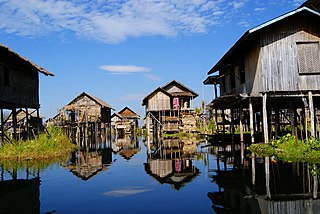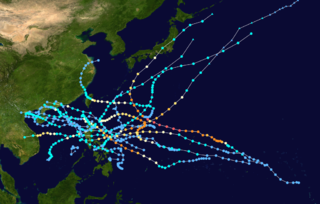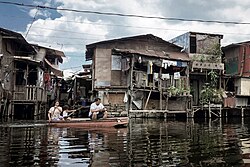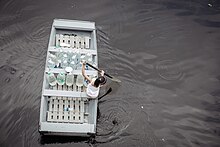
Samar, officially the Province of Samar, formerly named Western Samar, is a province in the Philippines located in the Eastern Visayas region. Its capital is the city of Catbalogan. It is bordered by Northern Samar, Eastern Samar, Leyte and Leyte Gulf, and includes several islands in the Samar Sea. Samar is connected to the island of Leyte via the San Juanico Bridge.

Malabon, officially the City of Malabon, is a 1st class highly urbanized city in the National Capital Region of the Philippines. According to the 2020 census, it has a population of 380,522 people.

Stilt houses are houses raised on stilts over the surface of the soil or a body of water. Stilt houses are built primarily as a protection against flooding; they also keep out vermin. The shady space under the house can be used for work or storage.

Typhoon Ketsana, known in the Philippines as Tropical Storm Ondoy, was the second-most devastating tropical cyclone of the 2009 Pacific typhoon season, causing $1.15 billion in damages and 665 fatalities, only behind Morakot earlier in the season, which caused 789 deaths and damages worth $6.2 billion. Ketsana was the sixteenth tropical storm, and the eighth typhoon of the season. It was the most devastating tropical cyclone to hit Manila, surpassing Typhoon Patsy (Yoling) in 1970.

Typhoon Parma, known in the Philippines as Super Typhoon Pepeng, was the second typhoon to affect the Philippines within the span of a week during September 2009.

The effects of the 2009 Pacific typhoon season in the Philippines were considered some of the worst in decades. Throughout the year, series of typhoons impacted the country, with the worst damage occurring during September and October from Typhoons Ketsana (Ondoy) and Parma (Pepeng).
Controversies abounded during the 2010 Philippine elections.

Typhoon Nesat, known in the Philippines as Typhoon Pedring, was the most powerful tropical cyclone to directly impact China since 2005. It also struck the Philippines during the 2011 Pacific typhoon season, killing 98 people. It is the 17th named storm, the 11th severe tropical storm, the 7th typhoon and overall, the 30th tropical cyclone to be monitored by the Japan Meteorological Agency(JMA) during the year. Nesat came exactly two years after Typhoon Ketsana made landfall in the Philippines as the most devastating typhoon in the 2009 Pacific typhoon season with a damage of US$1.09 billion and 747 fatalities. Nesat was also the first of twin tropical cyclones to batter the Philippines within one week during September 2011, the second was Nalgae.

Typhoon Nalgae, known in the Philippines as Typhoon Quiel, was a powerful tropical cyclone that struck the Philippines, and it affected Hainan, China as a weak tropical storm. Nalgae was the eighth typhoon and the fourth super typhoon in 2011. Forming as the 32nd tropical depression of the season, the system formed on September 26 over the Philippine Sea. On September 27, it was named Nalgae as it explosively intensified into a typhoon on the next day. Nalgae reached its peak intensity as a Category 4 typhoon on September 30 while it made landfall over Luzon. Nalgae weakened into a tropical storm as it entered the South China Sea on October 1. Nalgae made landfall over the island of Guandong in China on October 4 as it weakened to a tropical depression. Nalgae dissipated on October 5 east of Vietnam.

The ABS-CBN Broadcasting Center in Diliman, Quezon City, Philippines is the headquarters of the Philippine media conglomerate ABS-CBN Corporation and the television network of the same name. It houses the media conglomerate's divisions such as ABS-CBN News and ABS-CBN Entertainment and subsidiaries, broadcast facilities, offices, and ELJ Communications Center. It is also where the transmitter site of ALLTV is situated which was previously used by ABS-CBN before it became inactive due to the 2020 broadcast franchise renewal dispute with ownership of the transmitter and the land where it stands remain with the network. It occupies an area of 44,000 square meters including the ELJ Communications Center. It was originally built in 1968 and was then the most advanced broadcast facility in Asia. Today, it is now the country's largest and most technologically advanced media facility. Meanwhile, ABS-CBN's production facility is located at ABS-CBN Horizon IT Park in San Jose del Monte, Bulacan.

The House of Representatives Electoral Tribunal (HRET) is an electoral tribunal that decides election protests in the House of Representatives of the Philippines. It consists of six representatives and three justices of the Supreme Court of the Philippines, who are designated by the Chief Justice. The equivalent tribunals for elections to the upper house is the Senate Electoral Tribunal and for president is the Presidential Electoral Tribunal. The tribunal is located at SET-HRET Building, Commission on Audit Compound, Quezon City.

Protests against Former President Rodrigo Duterte escalated on November 18, 2016, following Duterte's support of the burial of the late president Ferdinand Marcos. These series of protests are mostly conducted by progressive groups and other opposing figures mainly due to the ongoing war on drugs, the declaration of martial law in Mindanao, and employment issues such as contractual terms being applied by companies and inflation which occurred due to the passage of the Tax Reform for Acceleration and Inclusion Law. Other causes of the protests include the government's response to the COVID-19 pandemic in the country, the passage of the Anti-Terrorism Act of 2020, and the shutdown and franchise denial of ABS-CBN.

The COVID-19 pandemic in Metro Manila was a part of the worldwide pandemic of coronavirus disease 2019 caused by severe acute respiratory syndrome coronavirus 2. The virus reached Metro Manila on January 30, 2020, when the first case of COVID-19 in the Philippines was confirmed in Manila. Metro Manila is the worst affected region in the Philippines, where most cases in the country are recorded. A state of calamity and community quarantine was declared in the region on March 15.

The renewal of the congressional franchise of the Philippine media network ABS-CBN to continue broadcasting was a dispute between the administration of President Rodrigo Duterte and the media conglomerate arising on the terms and conditions of the franchise renewal agreement. Amid the controversy, the Congress of the Philippines, country's legislature, was unable to renew the franchise before its expiration date. The congressional franchise expired on May 4, 2020, as the Philippines was dealing with the effects of the COVID-19 pandemic and the enhanced community quarantine in Luzon. The next day, exercising constitutional powers, the National Telecommunications Commission (NTC) then issued a cease-and-desist order demanding ABS-CBN to cease all of its free TV and radio broadcasting immediately. ABS-CBN complied with the government order and shut down all of its radio stations and free television channels later that day. On June 30, 2020, the NTC released two alias cease-and-desist orders against ABS-CBN TV Plus and Sky Direct.

Typhoon Vongfong, known in the Philippines as Typhoon Ambo, was a strong tropical cyclone that impacted the Philippines in May 2020. Beginning as a tropical depression on May 10 east of Mindanao, Vongfong was the first storm of the 2020 Pacific typhoon season. It gradually organized as it took a slow northward course, strengthening into a tropical storm on May 12 and curving west thereafter. The next day, Vongfong entered a period of rapid intensification, becoming a typhoon and attaining 10-minute maximum sustained winds of 150 km/h (93 mph). The storm made landfall at this intensity near San Policarpo, Eastern Samar, at 04:15 UTC on May 14. The system tracked across Visayas and Luzon, making a total of seven landfalls. Persistent land interaction weakened Vongfong, leading to its degeneration into a tropical depression over the Luzon Strait on May 17.

Urban areas in the Philippines such as Metro Manila, Metro Cebu, and Metro Davao have large informal settlements. The Philippine Statistics Authority defines a squatter, or alternatively "informal dwellers", as "One who settles on the land of another without title or right or without the owner's consent whether in urban or rural areas". Squatting is criminalized by the Urban Development and Housing Act of 1992, also known as the Lina Law. There have been various attempts to regularize squatter settlements, such as the Zonal Improvement Program and the Community Mortgage Program. In 2018, the Philippine Statistics Authority estimated that out of the country's population of about 106 million, 4.5 million were homeless.

Severe Tropical Storm Conson, known in the Philippines as Typhoon Jolina, was a strong tropical cyclone that impacted the central Philippines and Vietnam during the 2021 Pacific typhoon season. Being the thirteenth named storm of the said event, Conson originated as a low-pressure area first monitored approximately 500 km (310 mi) west of Guam. It formed as a tropical depression over the Pacific Ocean on September 5, 2021. As it formed within the Philippine Area of Responsibility, the Philippine Atmospheric, Geophysical, and Astronomical Services Administration (PAGASA) named the storm Jolina. Over the next day, it intensified into a tropical storm and was named Conson by the Japan Meteorological Agency (JMA). As the storm neared Samar Island, it intensified into a severe tropical storm, and later into a typhoon according to the PAGASA prior to its first landfall in Eastern Samar. The storm retained its strength as it crossed Visayas and later Calabarzon before weakening over Manila Bay prior to its final landfall in Bataan. It subsequently emerged into the South China Sea where it struggled to reintensify further. It then weakened into a tropical depression just offshore of Vietnam before moving ashore near Da Nang. It then rapidly weakened before dissipating on September 13.

In December 2022, a series of floods began to severely affect the provinces of Misamis Occidental and Misamis Oriental, and some parts of the southern island of Mindanao in the Philippines. The floods were caused by intense rain, which poured down on the central and southern parts of the country.


















